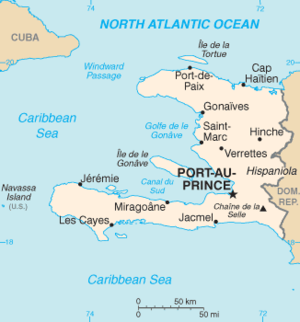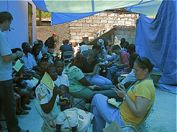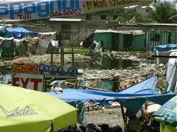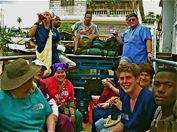Nurse, Practice Administrator and now Consultant Donna Izor, MS, FACMPE blogs about her trip to Haiti to provide medical relief.
As medical practice managers, we experience the challenge of providing care to patients each day. The success of our daily work depends upon our knowledge and experience and occurs within the constructs of policies and regulations.
Now imagine working in an environment without job descriptions, JCAHO or HIPAA. It is also without a facility, water or electricity. Patient care demand is high and access is limited or non-existent. Sound interesting? Then consider medical relief work.
The timing had never been right for me, but I was captivated by the stories of others providing needed medical care, doing jobs that may not be their expertise, struggling with a new language and learning about a new culture. Resigning a position as VP of Physician Services to begin my own consulting firm provided the opportunity to fill this dream. I had no idea when I would go, or where, but knew I wanted it to be within the next six months. I started speaking to friends who had gone on missions and asked they keep me in mind for future trips.
One friend emailed others and asked if they knew of relief missions going out within the next few months. Within a week I received an email that a medical team would be going from the Dominican Republic into Haiti and they were looking for workers.
I contacted the coordinator, a nurse practitioner located in the DR, and told her I was an administrator but had been a nurse though I hadn’t used my skills in 20 years.
She said my nursing skills would be helpful and I agreed to go. Hearing this my husband decided to join in and they were happy to have his skills as an engineer as part of our team.
Within one week I was able to collect over 70 pounds of the requested over the counter medications and dressings from friends, former practices and a local drugstore. People were very willing to help. Others gave us old scrubs that we could use then leave behind. There were some challenges ”“ finding a mosquito net in March when there is still snow on the ground but the planning went well and even the airline helped by allowing additional luggage. In less than two weeks from the initial email we were on our way to join medical teams for one week in Haiti and a second week in bateyes (sugar workers’ town) of DR.
We landed in the DR and traveled to the mission home location in La Romana to meet other team members and to learn about the work in Haiti. Our team consisted of two physicians, two medical students, a pediatric resident, several senior nursing students and their instructor, a pastor, a marketing executive, two nurses from Maine, a nurse from Nebraska and one from Alabama and several staff members of the mission living in the DR. Under the leadership of the coordinator, Kristy, we learned to work together and trust each other.

Image via Wikipedia
We spent the first day repackaging medications into small bags for patient distribution and organizing the food donations that we would also be bringing. A human chain made quick work of loading the two trucks. At 10pm we climbed into a bus to begin our trip. By 8 am were at the Haitian border, joining long lines of waiting trucks. We spent over 6 hours at the border while our coordinator worked hard to gain entry for us. The president of Haiti had declared that the disaster was over and the country was poised to manage the aftermath on its own. Send money, he’d direct it. Kristy knew how dire the circumstances were for the people of Haiti and persevered. We were allowed to enter and our “real” journey began.
There is nothing to prepare you for seeing the effects of an earthquake in a country little able to deal with it.
My husband described it as the difference in seeing a picture of the Grand Canyon and being at the Canyon looking over the rim. The vastness and sense of awe is little served by the picture. Port au Prince had been on the news in the three months since the quake yet the expanse of destruction, the poverty and lack of services for the people, and the sheer amount of rubble and garbage filling the streets was confounding.
We arrived in Port au Prince late in the afternoon and settled into the walled compound that would be our home for the week. On the grounds were a church, school, dormitory, kitchen, locked storage building used by the relief mission teams and several tents, home to the workers there. A generator provided electricity to run the fans and the water pump. Regretfully, it was old and often broke down meaning no showers and a very hot sticky night of sleeping.
Our days began early. After breakfast we loaded the open backed trucks with food, medicines, and tarps and then put in church pews to sit on before climbing in. Interpreters joined us for the rides. At that time, we were the only relief agency going into the neighborhoods to provide care. Because there was concern for the safety of relief workers, Kristy arranged to hire two off duty Haitian police officers for protection. We would ride through the city in amazement at the destruction, surprised not to see any other relief workers.
Huge water bladders from the Red Cross were located on several streets as well as temporary showers and port-o-lets. Any available space was occupied by a family with a make shift tarp or tent. Houses that had fallen down three months before were still spilled into the street with people walking through the debris.
People dug in the rubble of homes to release rebar so that it could be resold. This was hard to watch knowing that there were still bodies located there.
Reaching our destination, Kristy and the lead support person from DR would decide how the clinic would be set up while we waited in the truck, protecting the contents.
It took less than 30 minutes to unload the truck and set up the clinic with the entire team helping. Patients would be given a “ticket” allowing them to be seen. Then they would provide their name, age, and describe their current symptoms to a Haitian worker who put it on a yellow card that traveled with the patient. There were many who came because they knew that we had food and water but they were turned away. Hundreds waited in 90+ degree heat in the sun for the opportunity to be seen by the medical team.
After entering the clinic area, patients had their weight and blood pressure taken. The clinic area was a large space with providers sitting on benches next to their interpreter. Each provider had a box of “usual” medications including antacids, multi vitamins and acetaminophen for each age group. Patients waited quietly until they were escorted to a provider. With little examination, the provider indicated the likely diagnosis, gave medications from his box, and indicated the prescriptions to be given. The patient would move to the pharmacy where nurses and an interpreter completed the order. Then would then go to the de-worming station for all who were over 6 months old and not pregnant. Finally they moved to the gift station where a bag of food (2 pounds rice, 2 cans beans, and 1 can tomato sauce) was given to each family as well as soap and donated clothing while it lasted.

Providers are on one side with their interpreters and patients on the other. Kristy, our leader, is in yellow.
Each day nurses rotated through the various duties of taking vital signs, the pharmacy, the de-worming station and the gift station. Everyone took time to play with the kids and to live the motto we had been given,
“Do what you can, with what you’ve got, in the moment you’re given”.
We knew that many would not make it back to where they were living with the food they were given, but some would. That the 30 days of medications would run out, but for 30 days it would be all right. That the smiles we were seeing would fade to despair as the rain began, but for today the sun was shining.
The people we took care of were inspirational. If they were living in plastic covered tents, they were lucky. Many were still living under sheets held up by sticks. Their lives were a mess but they easily shared their smiles. The kids loved the attention, and getting them to leave the clinic was often difficult.

Not everyone is lucky enough to have a tent and have made do with what they have. Note the large amount of garbage.
The most common reason for being seen was grippe, a diagnosis that included any respiratory symptom and fever. Without an x-ray for confirmation, all patients were treated with antibiotics. We saw wound infections from surgery or treatments that occurred after the earthquake but had not been treated since. Dehydration, malnutrition, starvation, scabies, high blood pressure, upper gastric pain, and vaginal infections were some of the other diagnoses.
Treatment was basic. We had limited medications so routinely substituted others as inventory ran out. The clinic was loud but ordered. The organization that was developed by running these clinics over time was amazing given the conditions. What became hardest was leaving. We had to be back to the compound by dark and often this meant we had to pack up and leave a site before everyone could be seen.
Adults asked for care, children begged for water and food, yet many stayed to say thank you.
Our ride back to the compound included a stop at the General Hospital in Port-au-Prince where patients with severe illnesses were taken. You must realize that part of the hospital had collapsed and it did not have running water or electricity. The doctor who had seen them in the clinic accompanied Kristy into the ED to discuss the case with the physicians there. Often, the doctors at the hospital were from the US or Canada but doctors from there and many other nations were said to be working together. Once such case was a 5-month-old infant who had returned to birth weight. Another woman had an infection at a surgical site that would probably require amputation of her foot; another was a 3 year old with cellulitis surrounding her eye. We left them knowing that family members may not know where they were and that a ride back to where they were living would be difficult to come by.
Our trip back to the compound again brought us through the streets of Port-au-Prince. We saw downed houses, people selling anything and everything under colorful umbrella, and the mounds of plastic water bottles and Styrofoam containers garbage from the initial relief after the earthquake but now filling the canals meant to drain the city during the rainy season. We saw tent cities in areas that would be flooded with no place for these people to go. Others had set up their shelters in the median of the road. People shouted out to us for water and food, or just a greeting. We passed armed UN soldiers driving in jeeps through the city. The devastation was everywhere you looked.
When we returned, it was time to unload the trucks. If there was water, the lines for the shower began. People worked to repack the supplies for the next day and to enjoy a mango from one of the many trees on the compound. Dinner was always delicious and followed by a group meeting to discuss what we had seen and done for the day.
People shared their thoughts and some cried when discussing the level of illness, the people not able to be seen, or what we had seen on the ride to or from the clinic.
Several evenings the church came alive with music and prayer. I worked on a project to collect age, diagnosis and medications data to be used for Kristy to write grants and try to gain additional monies for future trips. Bedtime was early, and we were ready to sleep, as we would have an early start the next day. It was hot, especially when the fans were not working, but we had food, water and a roof over our heads. So much more than those we had cared for.
Leaving Haiti was difficult. There was so much more to do. There would always be so much more to do until the structure of the country became stable and one that would support all of its’ people. The ride back to the DR was much quieter. The border crossing into the DR was quick and easy. Only a flat tire slowed our travels.
Once back we unloaded the trucks, took long showers, and continued to debrief from the experience. Only my husband and I would be staying an additional week to work in the bateyes, so we began saying our good-byes to our teammates. I know that we will keep in contact with many as the years go by and our hope is to come together again in the future for another relief mission.
So can an administrator with past nursing experience learn from a relief mission? Yes, first about yourself and how you will endure conditions that you could only imagine.
Second you learn about others and the real meaning of doing what you can, for those that you see, with what you have and for that moment. I encourage each of you to embark on your own journey. You don’t need to leave the United States, there are many organizations that need help right here and I’m sure some right in your town. Be it a medical relief mission or participation on the local level, you will learn so much and it is so worth it.
Donna Izor, MS, FACMPE recently started West Pinnacle Consulting, LLC after 20 years as a medical practice executive. Her experience includes responsibility for primary care and specialty practices, employed inpatient physicians, regulatory oversight, facility design, physician compensation and relations, and new program development. She has worked with academic, community hospital, and private practices. You can contact Donna at donna.izor@gmail.com.




